Abstract
Trails are important recreation settings; determining an appropriate trail usage amount to avoid unacceptable ecological impacts is important for protected areas. However, there is a lack of studies examining trail usage’s direct and indirect relationships and the influence of landscape-level conditions to evaluate ecological carrying capacity. This study integrated a path analysis model and stakeholder assessment to estimate the ecological carrying capacity of trails in a protected area. This study surveyed the biophysical environment along the trails and conducted a path analysis to establish the use–impact model for the trails in the study area. Based on the use–impact model, this study developed four-level usage scenarios and collected the stakeholders’ acceptance evaluation to determine the ecological carrying capacity range. The results showed that the weekly usage of the trails directly affected the soil hardness and plant coverage of the trail. The trail’s soil hardness directly affected the surrounding soil hardness, decreasing its plant coverage, while the vegetation type and slope also affected its plant cover. The stakeholders of the Mt. Xiaoguanyin Area reached a consensus on the ecological carrying capacity range, which was 288 to 404 total weekly hikers. The study results revealed the effect paths of the landscape-level conditions and usage impacts and provided managers with an implementable ecological carrying capacity. The estimation framework could be a reference for determining ecological carrying capacity in other protected areas.
1. Introduction
As nature-based outdoor participation continues to grow [1], nature-based outdoor destinations face over-tourism issues. Recreation and tourism activities inevitably cause more or less sustainable environmental issues, especially in protected areas with recreation supplies. After the outbreak of the COVID-19 epidemic in 2020, a rapid and significant increase in outdoor recreation participation [2] led nature-based outdoor destinations to face intensified management pressures.
The management of nature-based outdoor destinations aims to conserve natural resources and provide high-quality outdoor recreation. In order to achieve a balance between conservation and use, managers need to have a comprehensive understanding of the state of natural resources and recreational use and predict the impacts of recreational use on the natural environment to form better management strategies [3,4]. Recreation carrying capacity is a common strategy that sets an appropriate amount for recreational usage to avoid unacceptable impacts [5,6,7]. Among the estimation perspectives, social carrying capacity is the most commonly used perspective (e.g., [8,9,10,11,12]), which evaluates the recreation carrying capacity based on how recreational usage affects the visitor experience (e.g., crowding experience, number of encounters, and satisfaction). From a social perspective, however, the status of the natural environment affected is not revealed. Ecological carrying capacity emphasizes the impact of recreational usage on the natural environment (e.g., animals, plants, soil, water, and air quality) [13]. Therefore, assessing recreation carrying capacity from an ecological perspective is more appropriate for protected areas with recreation supplies.
In terms of ecological carrying capacity estimation, several studies have used the method developed by Cifuentes [14], which estimates the maximum number of visits based on the physical environment, biological information, and management conditions of the site (e.g., [7,15,16,17,18]). The method is a load shedding that sets reducing coefficients for the environment to reduce the space available for recreation. Without being examined through actual use and its impact, the relationship might vary by site. More studies may be needed to set appropriate reducing coefficients. In addition, the method’s overlapping factors might deviate and give unrealistic results [19]. As Bednar-Friedl et al. [20] pointed out, an evidence-based approach to modeling the interactions between usage and the biophysical environment allows for deriving optimal usage levels consistent with a given area’s specific characteristics. Therefore, this study aims to establish a use–impact model through empirical research and use the model to simulate the subsequent outcomes of usage impacts on the study sites.
Trails are paths that direct people to engage in recreational activities in the natural environment and an important recreational activity setting, e.g., hiking. Increasing nature-based outdoor recreation participation has led trails to unplanned expansion and increased environmental pressure along trails. Research on the relationship between trail usage and the natural environment often focuses on the effects of trampling intensity on soil and vegetation [21]. Treading damages the plant structure and affects plants’ survival rate and coverage [22,23,24]; it may also lead to changes in the soil’s chemical composition, biota, and density, indirectly affecting plant root growth and triggering regional vegetation composition changes [25,26,27]. Therefore, trail usage causes not only direct impacts on the natural environment but also indirect impacts on ecological processes.
Moreover, ecosystems vary in resistance and resilience to disturbance [28,29]. For instance, gramineous plants are more resistant [30,31,32], while ferns in the forest understory are less resistant but more resilient [33]. In addition, higher-level environmental characteristics show control over lower-level conditions; land cover change and slope affect the bulk density of the soil [34], and steep slopes have a higher risk of erosion [35]. Therefore, trail usage may directly or indirectly cause damage to the natural environment, while the landscape-level conditions would influence these relationships. In the study by Sahani and Ghosh [36], they simultaneously examined the influences of environmental (landscape-level conditions) and trail-impact-related factors to predict and map trail susceptibility. The results showed that the trail susceptibility model established using logistic regression was the best. Integrating landscape-level conditions and impact-related factors into a model was reasonable; however, examining the direct and indirect relationships and the influence of landscape-level conditions might provide more insights.
Path analysis or structural equation modeling is a statistical technique that can be used to investigate the relationships and interrelationships between a set of measured variables in a conceptual model [37]. The method has also been used to investigate the effects of environmental changes on ecosystem processes. Paudel et al. [38] used structural equation modeling to indicate that estuarine flow directly affected nutrient concentrations and indirectly caused changes in phytoplankton. Using structural equation modeling, Mora [39] explored the effects of spatial integrity, naturalness, self-organization, and stability on ecological integrity. Kaveh et al. [40] used structural equation modeling to predict above-ground biomass and showed that climatic factors directly affect soil composition and then indirectly affect above-ground biomass.
Regarding the interactions between environmental factors at different scales, Grace and Keeley [41] investigated the relationships between landscape-level conditions and local-level factors to species richness of postfire plant diversity using structural equation modeling. They found that the local-level factors (heterogeneity, local abiotic conditions, fire severity, and plant cover) strongly influenced the postfire plant richness, and local-level factors could be predicted by the landscape-level conditions (landscape position and stand age). Similar direct and indirect causal relationships between variables could also be found in the studies concerning anthropogenic disturbance in the natural environment. Laigle et al. [42] established the causal model of forest harvesting on the composition of vegetation and soil fauna and their potential effects on leaf litter decomposition in forest ecosystems. From a broader scale, Yang et al. [43] established the direct and indirect influence paths of the fundamental natural environment (soil type and topography), human activity (land use, population density, road impact, and night lights), and NDVI to climate change. Thus, establishing the paths of the direct and indirect relationships and the influence of landscape-level conditions will reveal more insights and provide more information for determining and implementing ecological carrying capacity.
To determine recreation carrying capacity, Shelby and Heberlein [6] developed a framework with descriptive and evaluative components. The descriptive component describes the recreational use and impact relationships specific to the area. The evaluative component is a value judgment that depends on management objectives and social judgments of the level of impact to derive evaluative standards. For instance, Manning et al. [44] and Szuster et al. [45] assessed recreation carrying capacity through a descriptive component of actual use of the site and an evaluative component of tourist perceptions of the photographs. In the limits of acceptable change (LAC) planning systems, consensus among the affected groups about proposed actions is important for implementing protected area management strategies [5,46]. Empirical studies commonly adopted the framework to determine recreation carrying capacity, either from a social perspective (e.g., [47,48]) or an ecological perspective (e.g., [49]). However, there is a lack of studies examining the direct and indirect relationships and the influence of landscape-level conditions while evaluating ecological recreational carrying capacity.
Therefore, this study adopted path analysis to establish a use–impact model for the trails in the study area. Further, we integrated the stakeholders’ evaluation to determine the ecological carrying capacity of the trails. The case study is an ecological protected area within Yangmingshan National Park (YNP) in Taiwan.
2. Method
This study surveyed the biophysical environment along the trails and conducted a path analysis to establish the use–impact model. Based on the use–impact model, this study developed four-level usage scenarios and collected the stakeholders’ acceptance evaluation to determine the ecological carrying capacity range. The study procedure is shown in Figure 1.

Figure 1.
Study procedure of this study.
2.1. Study Area
The study area was the Mt. Xiaoguanyin Area, one of the ecological protected areas of YNP. The primary protected resources are Taiwan’s giant volcanic crater, the headwater of Datun Stream, biodiversity, and historic trails. The area has a hiking trail network consisting of historic trails, Pseudosasa usawai shoots harvesting trails, and ridge trails. Hiking is the only recreational activity allowed in the area. Three hiking routes were available for application, including the Y-shaped route (Figure 2a), the Small-O-shaped route (Figure 2b), and the Large-O-shaped route (Figure 2c). The vegetation type of the area was the Machilus thunbergii type at low altitudes and the Pseudosasa usawai type at high altitudes. The trail slope was flat on the ridges (R-section in Figure 2) and steep on the valleys (T-section in Figure 2). The trail’s tread was mainly covered with volcanic ash soil; some were Andesite rock. The increasing number of hikers has caused soil compaction on the tread and reduced vegetation coverage along the trail.
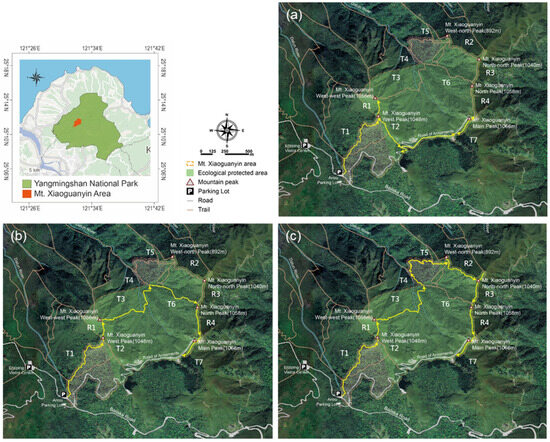
Figure 2.
Trail network and the three hiking routes in the Mt. Xiaoguanyin area: (a) the Y-shaped route, (b) the Small-O-shaped route, and (c) the Large-O-shaped route.
2.2. Use–Impact Model Establishment
2.2.1. Use–Impact Survey along the Trails
According to this study’s pilot survey of the biophysical environment along the trails in Mt. Xiaoguanyin, we divided the trails into eleven sections: valley sections from T1 to T7 and ridge sections from R1 to R4. Since the usage of the trails in Mt. Xiaoguanyin is under control, a nearby trail section (D1, a section of Datun Mountain Trails) with a similar biophysical environment (soil type, slope, tread cover, and vegetation) but without the entry application requirement was included in the survey, to including more variation (Figure 3).
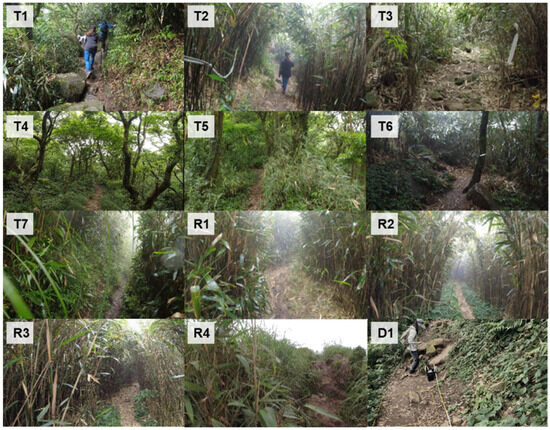
Figure 3.
Photos of the trail sections.
This study set an observation point every 200 m and at least two observation points for each section. A total of 38 observation points, the Mt. Xiaoguanyin Area had 36 observation points, and D1 had 2 observation points (Figure 4).
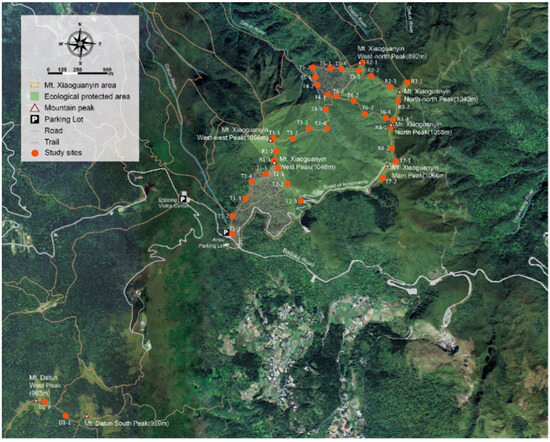
Figure 4.
Observation points of the trails.
For each observation point, this study set up a sample plot on the trail (with the observation point as the center) and set a reference plot off the trail that paralleled with the left or right side of the sample plot. The reference plot was 1 m apart from the trail’s edge. The dimensions of the plots are 1 × 1 m. In addition, this study extended 2 m front and behind the sample plot as an extended survey area (Figure 5).
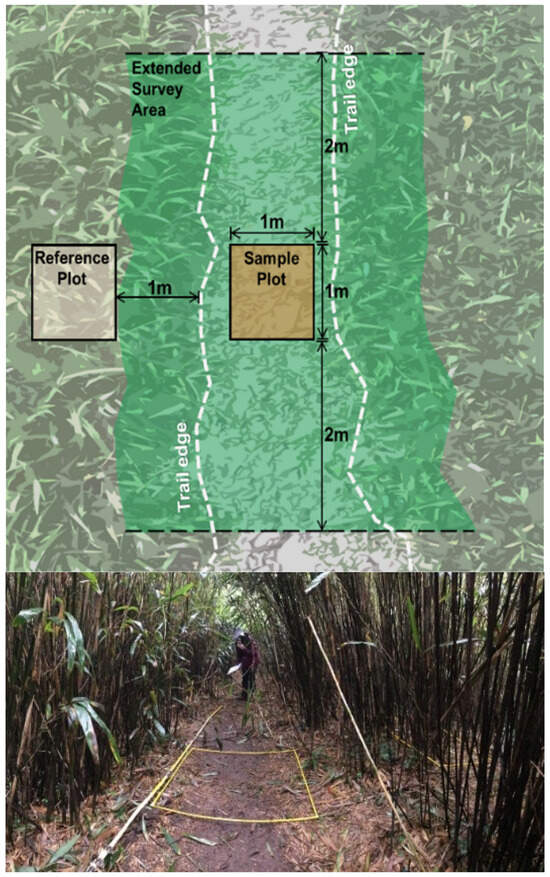
Figure 5.
Schematic diagram of the observation point, sample plot, reference plot, and extended survey area.
Based on this study’s pilot survey, we developed the biophysical environment survey variables and approaches, as shown in Table 1. The Mt. Xiaoguanyin area is an ecologically protected area and prohibits any usage except hiking with a permit, so the fauna is not affected significantly. In addition, the occurrence of conservation species Viverricula indica showed no significant correlation with the hiking trails [50]. This study excluded the impact of usage on fauna.

Table 1.
Variable and survey method.
The survey day was selected with the day and the previous day with sunny or cloudy weather, avoiding rainy weather. Five days were surveyed from 8:00 a.m. to 5:00 p.m., including 7 Octobar, 29 Octobar, 11 November, 3 December, and 4 December 2021.
This study surveyed (1) the landscape-level conditions of the trails, vegetation type, and slope and (2) the use–impact factors: trail width, soil hardness, plant coverage, and plant species. In the extended survey area, we recorded the vegetation type, measured the slope of the long axis of the extended survey area, and recorded plant species within the 1 m depth from the edge along the trail in the extended survey area. We measured the soil hardness and plant coverage in the sample and reference plots. We randomly measured three points of soil hardness within the plot with a soil hardness tester (measurement range: 0~40 mm and 0~500 kg/cm2; Zhejiang Top Cloud-Agri Technology Co., Ltd., Hangzhou, China). A photographic method was used to determine the plant coverage of the plot. We photographed the plot with the camera lens positioned parallel to the ground. ImageJ v1.53 (National Institutes of Health, Bethesda, MD, USA) was then used to analyze the plant coverage in the plot. The trail width was the widest section of the trail near the sample plot and was measured with a measuring tape (Table 1).
2.2.2. Trail Usage Counting and Estimating
This study used infrared trigger cameras to record the actual usage of the trails. Statistics on the number of visitors to the Mt. Datun Visitor Service Center were used to estimate the peak trail usage. Details are as follows.
- A.
- Infrared trigger camera setting and trail usage
This study installed six infrared trigger cameras (KeepGuard, KG790, KeepWay Industrial (Asia) Co., Ltd., Shenzhen, Guangdong, China) in the main intersection of the trails (Figure 6). We set the infrared trigger camera to record a photo every 30 minutes and a photo for each trigger event with a 3-second delay between trigger events. The recording of infrared trigger cameras was from 1 October to 30 November 2021.

Figure 6.
Location of infrared-triggered cameras.
This study counted trail section hikers every 30 min, including go-and-back hikers, to cover all the trail usage (Figure 7). The usage calculations for each trail section are listed in Table 2. Following the name of the trail section, ① C meant the number of hikers recorded by the No. ① camera with a clockwise walking direction, while ① A meant the number of hikers recorded by the No. ① camera with an anticlockwise walking direction. T3, T4, and T5 are far from the entrance and have no infrared trigger camera installation. Therefore, we estimated the total number of T3, T4, and T5 hikers by the must-pass-through sections.
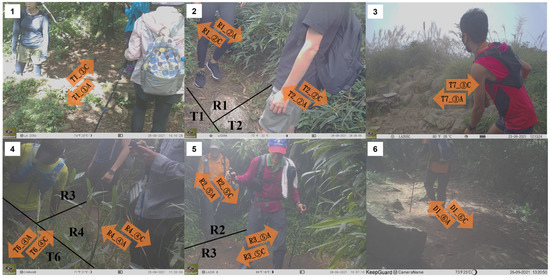
Figure 7.
Photo and the counting method for each infrared trigger camera.

Table 2.
Usage calculation for each trail section.
In addition to counting and estimating the usage of the trail section, this study estimated the total number of hikers in the Mt. Xiaoguanyin Area without a double counting problem. According to this study’s pilot survey, hikers mainly access the Mt. Xiaoguanyin Area through the entrances in T1 or T7. The T1 entrance is the most popular because it is near the Anbu parking lot.
Furthermore, the Y-shaped route hikers access the Mt. Xiaoguanyin Area through the entrance on T1, hike to the west peak, and then proceed to the main peak through the entrance on T7. To accurately estimate the total number of hikers (X) in the Mt. Xiaoguanyin Area, this study utilized the following equation:
X = T1_①C + T7_③A − T2_②C
Since the trail usage showed variance between weekdays and weekends, we estimated the weekly trail usage instead of daily.
- B.
- Estimation and calibration of the trail peak usage
The study period was from October to November 2021, while the COVID-19 pandemic is still ongoing. The previous trail usage that impacted the biophysical environment along trails might not be revealed by analyzing the trail usage by the infrared trigger camera recordings. Therefore, this study used the visitor number statistics of the Mt. Datun Visitor Service Center, the nearest visitor service center, from the past five years to estimate and calibrate the peak trail usage.
Between 2017 and 2020, the number of visitors to the Mt. Datun Visitor Service Center was higher in July and August (summer break), followed by April and May, and lower in June, December, and January because of rain. Similarly, hikers to the Mt. Xiaoguanyin Area peaked at the weekend and dropped off when the weather turned bad. The average visitor number of the Mt. Datun Visitor Service Center from October to November in 2017 to 2020 was 34,008, 1.08 times in the same period of 2021. Therefore, this study used 1.08 to calibrate the usage back to the situation without the pandemic. In the past five years, July to August was the peak visitation period, with an average visitor number of 59,793, 1.76 times greater than the average number of 34,008 from October to November. Thus, this study used 1.76 to further estimate the usage to the peak time. Overall, the total number of hikers for each trail section was multiplied by 1.90 (1.08 × 1.76) to derive the peak trail usage.
2.2.3. Conceptual Use–Impact Model
According to the literature review, trail treading decreased vegetation coverage [22,23,24] and increased soil density, which affected plant root growth and indirectly triggered regional vegetation composition changes [25,26,27]. Moreover, landscape-level conditions showed control over local-level conditions [28,29,34,35,40,43]. Vegetation types varied in resistance to disturbance [30,31,32], and steep slopes had a higher erosion risk [35]. This study proposed a conceptual model that depicted the influence paths of the direct and indirect impacts of trail usage and the influences of landscape-level conditions.
In Figure 8, the trail usage directly impacted the soil hardness and plant coverage over the trail tread and the number of plant species along the trail. It indirectly impacted the soil hardness of the edge and beyond the trail, then damaged the plant coverage of the edge and beyond. The landscape-level conditions, including vegetation type and slope, could increase or decrease the impact process.
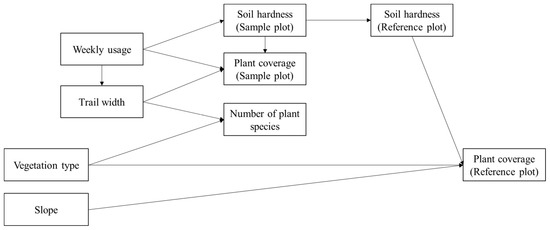
Figure 8.
A conceptual model depicted the influence paths of trail usage’s direct and indirect impacts and the influence of landscape-level conditions.
This study collected cross-sectional data to validate the conceptual model. We first conducted a Pearson correlation analysis to test the relationships among the variables. Then, we used Amos 26.0 software (IBM Corp., Somers, NY, USA) to perform a path analysis and determine the goodness-of-fit of the model.
2.3. Stakeholders’ Acceptance Evaluation
2.3.1. Scenarios Simulation
This study adopted the use–impact model to stimulate four-level usage scenarios with low to high levels of trail usage and the corresponding outcomes of the biophysical environment along the trails. According to the survey of the biophysical environment along the trails, T1 was the relatively damaged section. Therefore, we selected T1 to take a photo showing the trail, trail tread, and surrounding natural environment as the simulation setting. The scenarios were visually presented to the stakeholders using the photo simulation method. Then, we used a structured questionnaire to collect the evaluation of the stakeholders toward the use–impact scenarios.
This study took the plant coverage of the reference plot of T1 as the scenario simulation target. Taking the current status as the baseline level, we developed four-level usage scenarios with low to high levels of trail usage. The plant coverage of the reference plot of T1 included an increase of 4%, baseline level, a decrease in plant coverage by 10%, and a reduction in plant coverage by 20%.
2.3.2. Stakeholder Evaluation Survey
The stakeholders of the Mt. Xiaoguanyin Area included experts and the public. The interviewed experts were scholars (n = 6), Alpine Association representatives (n = 15), local opinion leaders (n = 3), and managers of the YNP and related administrations (n = 10). We conducted an in-person interview or an online survey from 1–17 April 2022. A total of 34 experts were interviewed.
The public interviewed were the hikers (n = 265) and visitors (n = 175) in YNP. This study selected three weekdays (7, 8, and 12 April 2022) and five weekends (9, 10, 16, and 17 April 2022) to conduct random sampling an in-person interview at the Anbu parking lot (close to the most popular entrance) and Erziping Visitor Center (about 600 m from the Anbu parking lot). A total of 440 public were surveyed.
The structured questionnaire was used to collect the acceptance evaluation of the stakeholders toward the use–impact scenarios. The structured questionnaire included four parts: (1) background information about the Mt. Xiaoguanyin Trails, (2) acceptance evaluation for the scenarios, (3) hiking experience, familiarity with the Mt. Xiaoguanyin Area, and pro-environmental behavior, and (4) personal information. Regarding pro-environmental behavior, this study defines individuals consciously and to the maximum extent possible to reduce their negative impacts on the environment, referring to Kollmuss and Agyeman [51]. We asked respondents about the frequency of engaging in behaviors aimed at consciously reducing the negative impact on the environment on a scale of 1 to 10, with higher scores indicating a higher frequency. Familiarity with Mt. Xiaoguanyin was assessed on a scale of 1 to 10, with higher scores indicating greater familiarity.
Regarding acceptance evaluation for the scenarios, we asked the respondents to answer the highest and lowest accepted scenarios. For each scenario, two simulated photos were produced. The first photo depicted the biophysical environmental impact, including changes in ground soil hardness, surrounding soil hardness, and variations in vegetation coverage. The second photo portrayed peak trail usage. Each respondent first viewed the biophysical environment photos of the four scenarios simultaneously, followed by photos with hikers present. Before determining the acceptance range of ecological carrying capacity, this study used Spearman rank correlation analysis to examine whether there are significant correlations between stakeholders’ familiarity with the Mt. Xiaoguanyin Area, pro-environmental behavior, and accepted scenarios regarding the highest and lowest accepted.
2.3.3. Acceptance Range of Ecological Carrying Capacity
This study defined ecological carrying capacity as the range within which the impact was deemed acceptable, from the lowest to the highest carrying capacity. The lower threshold was the minimum acceptable impact, while the upper threshold was the maximum acceptable impact. The stakeholders’ ecological carrying capacity range thresholds were determined using the turning point and percentage methods.
The turning point method compared the acceptable population percentage between adjacent scenarios and identified the two with the most significant difference (the largest slope) [52]. The higher percentage from these was then selected as the turning point. Meanwhile, the percentage method relied on judging the proportion, where the higher percentage from the various scenarios is considered the acceptable threshold. This study suggested an acceptable ecological carrying capacity range by comparing the stakeholders’ thresholds for the ecological carrying capacity range derived from the two methods.
3. Results
3.1. Use–Impact Model
3.1.1. Trail Usage
Weekly usage of the trails is shown in Figure 9. The D1 without an entry application requirement showed the greatest weekly usage (1527 hikers/week). In the Mt. Xiaoguanyin Area, T1 had the most usage (621 hikers/week), followed by R1 (554 hikers/week) and T7 (359 hikers/week).
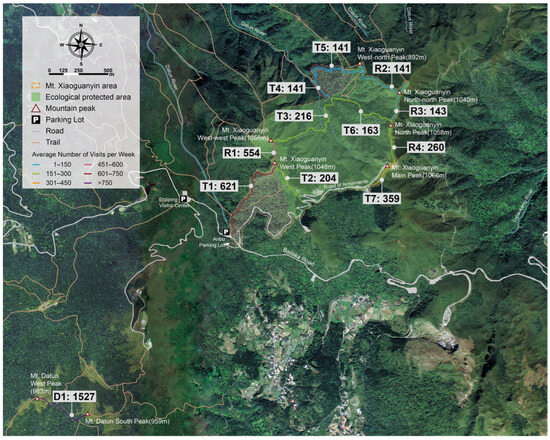
Figure 9.
Weekly usage of each trail section.
Regarding the total number of hikers in the Mt. Xiaoguanyin Area, weekdays ranged from 0 to 82, averaging 39 hikers, while weekends ranged from 0 to 220, averaging 104 hikers. The number of hikers on weekends was 2.6 times that on weekdays. On average, the weekly number of hikers in the Mt. Xiaoguanyin Area was 404.
3.1.2. Landscape-Level Conditions and Use–Impact Factors along the Trails
The survey results of landscape-level conditions and use–impact factors along the trails are shown in Table 3. Regarding the landscape-level conditions of the trails, the vegetation type of the observation points was mostly the Pseudosasa usawai type and the Machilus thunbergii type, while some observation points were under the vegetation transition zone. The slope ranged from 0.7 to 30.2%, from relatively flat to steep.

Table 3.
Survey results of the landscape-level conditions and use–impact factors along the trails.
In terms of the use–impact factors, the trail width averaged 85.1 cm. Wider trails were mostly located under the Machilus thunbergii type; the widest trail was 270 cm (T2–3). The soil hardness of the sample and reference plots was higher in D1, R1, and T2. The sample plot with less plant coverage occurred in T1, T2, and T3, while the reference plot with less plant coverage occurred in T6. Regarding the number of plant species, D1, T6, and T4 found more plant species than other trail sections; most were under the Machilus thunbergii type. Some rare species were found in T2 and D1, including Sceptridium formosanum (assessed as Near Threatened by the Red List of Vascular Plants of Taiwan) and Begonia ravenii (assessed as Near Threatened by IUCN and the Red List of Vascular Plants of Taiwan).
3.1.3. The Use–Impact Model
- A.
- Relationship between Use and Impact
This study conducted a Pearson correlation analysis to reveal the correlations between weekly usage, landscape-level conditions, and use–impact factors. As shown in Table 4, weekly usage significantly correlated with soil hardness and plant coverage of the sample plot; the higher the weekly usage, the higher the soil hardness and the lower the plant coverage. In addition, the greater weekly usage had more plant species found within the 1 m depth from the edge along the trail in the extended survey area. This might be the contribution of the edge effect, which is that wider trails and more hikers brought more chances for plant species to grow.

Table 4.
Pearson correlation analysis results of the relationships between usage, landscape-level conditions, and use–impact factors.
Regarding the relationships between landscape-level conditions and use–impact factors, vegetation type and slope could affect the use–impact response. Under the Pseudosasa usawai type, plant coverage of the reference plot was lower but was richer in plant species than those under the Machilus thunbergii type. Because Pseudosasa usawai spreads by sending out rhizomes or stems underground, the plant species under the Pseudosasa usawai type are mostly Pseudosasa usawai. In contrast, multiple plant species could be found under the Machilus thunbergii type, but without dense rhizomes or stems, showed low plant coverage. In addition, the slope had a significantly negative relationship with plant coverage of the reference plot, which meant that a steeper slope caused less plant growth.
From the relationship between weekly usage and soil hardness and plant coverage of the sample plot, this study further examined the indirect effect of trail usage. The soil hardness of the sample plot showed a significantly positive correlation with the soil hardness of the reference plot and the number of plant species. The soil hardness of the reference plot had a negative relationship with the plant coverage of the reference plot.
- B.
- Path analysis result of the Use–Impact model
According to the conceptual model (Figure 8) and relationships among the variables (Table 4), this study further conducted a path analysis. The goodness-of-fit test of the path analysis resulted in a χ2 of 25.816 (p = 0.274) and χ2/df = 1.229, indicating a good fit for the model. The model fit indices are CFI = 0.916, GFI = 0.857, RMSEA = 0.079, and IFI = 0.925, which also fit the model well (Table 5).

Table 5.
Goodness-of-fit test of the final use–impact model.
The path analysis results are shown in Table 6 and Figure 10. In Table 6, all conceptual paths reached statistical significance (p < 0.05). As shown in Figure 10, the increased weekly usage of the trails directly caused soil hardness and plant coverage of the sample plot. The hardened soil of the sample plot further caused the soil hardness and plant coverage of the sample plot. The landscape-level conditions showed their influence on the plant coverage of the reference plot.

Table 6.
Path results of the use–impact model.
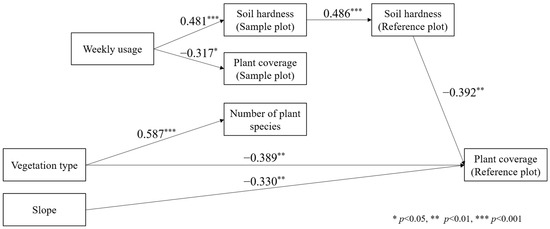
Figure 10.
Path analysis result of the final use–impact model. Pseudosasa usawai type as a reference vegetation type.
According to the final use–impact model (Figure 10), we further conducted a regression analysis to formulate prediction equations as follows:
where PCR is the plant coverage of the reference plot (%); SHR is the soil hardness of the reference plot (kg/cm2); SHS is the soil hardness of the sample plot (kg/cm2); VT is the vegetation type with the Pseudosasa usawai type as a reference vegetation type; S is the slope (%); and WU is the weekly usage (number of hikers).
3.2. Evaluation of Ecological Carrying Capacity
3.2.1. Simulated Scenarios
According to the use–impact model, this study simulated the four-level usage scenarios using Equations (2)–(4). First, we input the plant coverage of the reference plot of T1 (PCR) of the scenario into Equation (2) to derive the soil hardness of the reference plot of T1 (SHR). The SHR value was then used in Equation (3) to compute the soil hardness of the T1 (SHS) sample plot. Subsequently, the SHS value was inserted into Equation (4) to determine T1’s weekly usage of the scenario. Second, assuming that the proportion of weekly usage for each section remained constant (Figure 9), the weekly usage for each section of each scenario was estimated proportionally. Then, Equations (2)–(4) were applied sequentially to calculate each section’s SHS, SHR, and PCR.
This study took the plant coverage of the reference plot of T1 as the scenario simulation target. Taking the current usage level as the baseline level, we developed four-level usage scenarios with low to high levels of trail usage. The plant coverage of the reference plot of T1 and the total number of hikers per week of the four-level scenarios were (1) Scenario 1: increased by 4% with 288 total hikers per week, (2) Scenario 2: baseline level with 404 total hikers per week, (3) Scenario 3: decreased by 10% with 696 total hikers per week, and (4) Scenario 4: decreased by 20% with 988 total hikers per week.
- A.
- Scenario 1: increased by 4% with 288 total hikers per week
In scenario 1, the total number of hikers per week in the Mt. Xiaoguanyin Area was 288. Weekly hikers per week for each section ranged from 101 to 442. The plant coverage of the T1 reference plot increased by 4% to 43.7%, and the average plant coverage of the reference plot of the sections ranged from 43.7% to 72.8%. The average plant coverage of the sample plot of the sections ranged from 8.8% to 14.6%. The average soil hardness of the reference and sample plots of the sections ranged from 2.4 to 2.8 kg/cm2 and 10.9 to 15.7 kg/cm2, respectively (Table 7).

Table 7.
Usage and biophysical environment of Scenario 1.
- B.
- Scenario 2: baseline level with 404 total hikers per week
In scenario 2, the baseline level, the total number of hikers per week in the Mt. Xiaoguanyin Area was 404. Weekly hikers per week for each section ranged from 141 to 621. The average plant coverage of the reference and sample plots of the sections ranged from 42.0% to 72.4% and 5.7% to 13.9%, respectively. The average soil hardness of the reference and sample plots of the sections ranged from 2.5 to 3.0 kg/cm2 and 11.5 to 18.2 kg/cm2, respectively (Table 8).

Table 8.
Usage and biophysical environment of Scenario 2.
- C.
- Scenario 3: decreased by 10% with 696 total hikers per week
In scenario 3, the total number of hikers per week in the Mt. Xiaoguanyin Area was 696. Weekly hikers per week for each section ranged from 244 to 1070. The plant coverage of the T1 reference plot decreased by 10% to 37.8%. The average plant coverage of the reference and sample plots of the sections ranged from 37.8% to 71.5% and 0.0 to 12.1%, respectively. The average soil hardness of the reference and sample plots of the sections ranged from 2.6 to 3.5 kg/cm2 and 12.9 to 24.5 kg/cm2, respectively (Table 9).

Table 9.
Usage and biophysical environment of Scenario 3.
- D.
- Scenario 4: decreased by 20% with 988 total hikers per week
In scenario 4, the total number of hikers per week in the Mt. Xiaoguanyin Area was 988. Weekly hikers per week for each section ranged from 346 to 1518. The plant coverage of the T1 reference plot decreased by 20% to 33.6%. The average plant coverage of the reference and sample plots of the sections ranged from 33.6% to 70.5% and 0.0% to 10.4%, respectively. The average soil hardness of the reference and sample plots of the sections ranged from 2.7 to 4.0 kg/cm2 and 14.3 to 30.7 kg/cm2, respectively (Table 10).

Table 10.
Usage and biophysical environment of Scenario 4.
This study selected T1 as the simulation setting and further visually simulated the four-level scenarios, as shown in Figure 11. A total of eight photos were simulated.
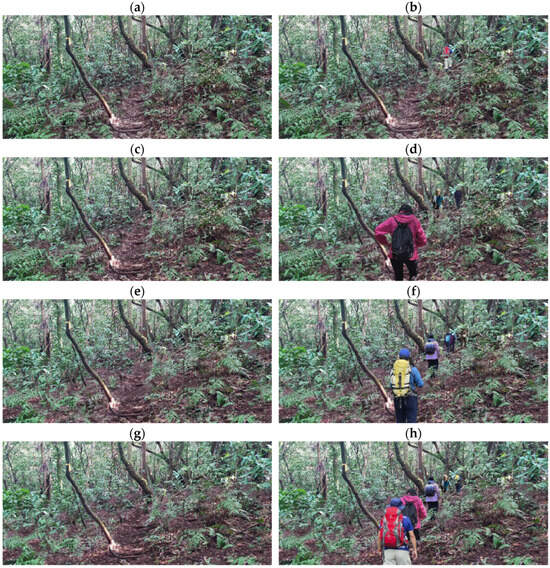
Figure 11.
Simulated photos of the four scenarios showing usage impact on the biophysical environment. (a) Scenario 1; (b) Scenario 1 with hikers presented; (c) Scenario 2; (d) Scenario 2 with hikers presented; (e) Scenario 3; (f) Scenario 3 with hikers presented; (g) Scenario 4; (h) Scenario 4 with hikers presented.
3.2.2. Acceptance Evaluation of the Stakeholders
The highest accepted scenario was Scenario 4 for Alpine Association representatives and local opinion leaders. The highest accepted scenario for visitors was Scenario 3, while hikers and managers were Scenario 2 and Scenario 3. The highest accepted scenario for scholars was scenario 2. Regarding the lowest accepted scenario, scholars, local opinion leaders, managers, hikers, and visitors were Scenario 1, while the lowest accepted scenario of Alpine Association representatives was Scenario 2 (Table 11).

Table 11.
Spearman rank correlation analysis results between familiarity level, pro-environmental behavior, and the accepted scenario.
In terms of familiarity with the Mt. Xiaoguanyin Area, scholars had a mean of 5.8 (SD = 3.0), Alpine Association representatives had a mean of 5.8 (SD = 2.5), hikers had a mean of 5.6 (SD = 2.5), local opinion leaders’ mean scored 5.0 points (SD = 0.0), managers’ mean score was 4.2 (SD = 2.2), and visitors had a mean of 3.9 (SD = 2.8). The pro-environmental behavior of the stakeholders from high to low were hikers (mean = 8.6, SD = 1.6), visitors (mean = 8.4, SD = 1.9), managers (mean = 7.9, SD = 1.0), scholars (mean = 7.7, SD = 1.2), local opinion leaders (mean = 7.3, SD = 1.2), and Alpine Association representatives (mean = 7.1, SD = 2.0). A Spearman rank correlation analysis revealed negative correlations between stakeholders’ familiarity with the Mt. Xiaoguanyin Area, pro-environmental behavior, and accepted scenarios regarding the highest and lowest accepted. However, these correlations did not reach a significant level (Table 11).
3.2.3. Acceptance Range of Ecological Carrying Capacity
Based upon the acceptance evaluation of the stakeholders, this study determined the ecological carrying capacity range using the turning point (Figure 12a,c) and percentage methods (Figure 12b,d). The ecological carrying capacity ranges of the stakeholders are listed in Table 12.
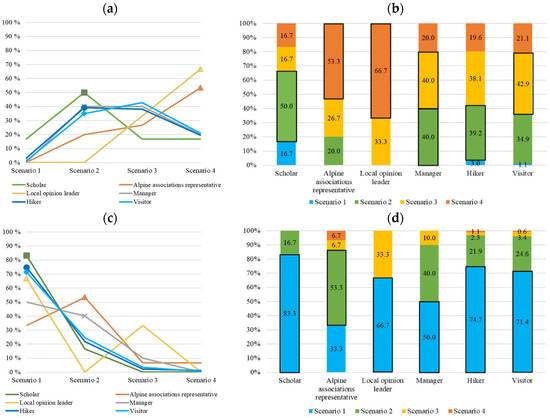
Figure 12.
Line charts of (a) the highest accepted scenario and (c) the lowest accepted scenario of the stakeholders using the turning point method. Bar charts of (b) the highest accepted scenario and (d) the lowest accepted scenario of the stakeholders using the percentage method.

Table 12.
The accepted ecological carrying capacity interval of the stakeholders.
Using the turning point method, the ecological carrying capacity range of the scholars was relatively stringent. The lowest and highest accepted scenarios were Scenario 1 and Scenario 2, respectively; the ecological carrying capacity range was 288–404 total hikers per week. The ecological carrying capacity ranges were broader for Alpine Association representatives (404–988 total hikers per week) and local opinion leaders (288–988 total hikers per week). The upper and lower threshold values for managers were the same, set at 404 total hikers per week. Both hikers and visitors fell within the range of 288–404 total hikers per week. The stakeholders of the Mt. Xiaoguanyin Area had a consensus on the range of ecological carrying capacity of 288–404 total hikers per week.
Using the percentage method, the results for scholars, Alpine Association representatives, and local opinion leaders align with the results from the turning point method. However, there were differences for managers, hikers, and visitors. Both managers and hikers indicated the highest acceptable usage levels in Scenario 2 (404 total hikers per week) and Scenario 3 (696 total hikers per week), and the percentages were nearly identical. Their ecological carrying capacity ranges were between 288 and 404 total hikers per week or between 288 and 696 total hikers per week. Visitors’ ecological carrying capacity range was between 288 and 696 total hikers per week. The consensus on the ecological carrying capacity range of the stakeholders of the Mt. Xiaoguanyin Area was 288–404 total hikers per week and 288–696 total hikers per week.
When comparing the results using two methods (Table 12), the percentage method represented the majority opinion, but it might lead to ambiguous range determinations. In contrast, the turning point method determined thresholds more clearly and explicitly by utilizing the maximum slope for judgment, thereby avoiding the issue of ambiguous range determinations. Therefore, this study adopted the turning point method to identify the ecological carrying capacity range as 288 to 404 total hikers per week.
4. Discussion
According to relevant studies [34,35,36,42,43], the impacts of usage on the biophysical environment might involve direct and indirect effects. In implementing practice, the consensus of the stakeholders is crucial [5,46]. Therefore, integrating direct and indirect relationships, the effects of landscape-level conditions, and the stakeholder assessments in ecological carrying capacity estimation can provide a more scientific basis and increase implementation practices. In the following section, we discussed our study from the scientific and application aspects:
4.1. Use–Impact Model
4.1.1. The Affect Paths of the Landscape-Level Conditions and Usage Impacts
Since the usage of the trails in Mt. Xiaoguanyin is under control, no severe root exposure or trail erosion was observed in most of the trails. However, the higher usage resulted in greater impacts on the biophysical environment (Table 4), which aligns with previous studies [21,22,23,24,41,42,43].
Using a path analysis, this study established the use–impact model to reveal the affect paths of the landscape-level conditions and usage impacts. As shown in Figure 10, increased usage directly caused the soil hardness and decreased plant coverage of the trail. Then, it indirectly increased the surrounding soil hardness and further reduced its plant cover. Beyond the anthropogenic influences at the local scale, landscape-scale conditions were important factors that influenced the extent of disturbance in the ecosystem. In this study, the landscape-scale conditions where the trail was located affected the number of plant species and plant coverage. Compared to the trails under the Pseudosasa usawai vegetation type, the trails under the Machilus thunbergii vegetation type were more affected by usage, and the steeper the slope, the more pronounced the impact. Similar results were found compared to previous studies that have not investigated the effect paths [32,33,35,36]. However, a path analysis model could more explicitly reveal the direct and indirect relationships and the influences of landscape-level conditions.
4.1.2. Impact Factors and Future Path Model Refinement
Although several factors affect the ecological environments of trails, this study selected the impact factors that were manageable, easily observed, and significantly correlated factors into the path analysis model. However, other potential factors could be investigated in the future. For example, relevant studies have shown that climate is an important driver of environmental change; e.g., temperature, precipitation patterns, and sunlight duration affect the growth and distribution of vegetation [53]. Since the Mt. Xiaoguanyin area is located within the same climatic zone, the effects of climate should be consistent across the different measurement points. Therefore, climatic factors were not considered in this study. During the survey period, varying degrees of vegetation shading were observed, which may affect the likelihood of trail exposure to light or rain erosion, which in turn affected soil temperature [54], vegetation richness, and coverage [29,55]. Future investigations could further explore the influences of macroclimate and microclimate on usage impacts.
Moreover, the infrared trigger cameras recorded several instances of the conservation species Viverricula indica. This species is nocturnal and has an annual home range of 19.46 km2. No significant correlation existed between its occurrence frequency and the hiking trails [50]. Future studies could simultaneously examine the trail usage impacts on target species that are sensitive to hiking use.
This study investigated the effect paths of the landscape-level conditions and usage impacts using cross-sectional research. Due to ecological responses having a time lag, long-term monitoring is needed to detect and polish the affect paths more comprehensively.
4.2. Evaluation of Ecological Carrying Capacity
4.2.1. Objective and Subjective Estimation of Ecological Carrying Capacity
This study established a use–impact model and applied the model to stimulate four-level usage scenarios. Further, we conducted an acceptable evaluation from stakeholders of the Mt. Xiaoguanyin Area to reach a consensus on the ecological carrying capacity range. The study results provided a scientific-based practice for managers to make corresponding strategies.
Compared with previous ecological carrying capacity studies that adopted load shedding [7,14,15,16,17,18], the methods used in this study would not only reveal the affect paths but also derive a consensus based on the value judgments of the stakeholders. Although a field survey and stakeholder interview were costly, the suggested ecological carrying capacity was based on objective and subjective estimations. Therefore, the reliability and utilization would be increased significantly.
4.2.2. Long-Term Monitoring and Rolling Adjustment
The carrying capacity is a concept but not a constant value, depending on the changing interaction between physical factors and human development [56]. Therefore, long-term monitoring of the biophysical environment and knowing stakeholders’ value judgment was important. The managers could use the use–impact model to predict the impact of trail usage on the trail and surrounding environment. The managers could also incorporate the affect paths into their routine observation and monitor plan. For example, set up key plots on and off the trail to survey the soil hardness and planting coverage and use the model to adjust the trail usage on a rolling basis.
The key to the LAC process is determining the amount of acceptable change to stakeholders [57]. The stakeholders of the Mt. Xiaoguanyin Area included scholars, Alpine Association representatives, local opinion leaders, managers, hikers, and visitors. The interviewed scholars who have participated in relevant research in the Mt. Xiaoguanyin Area were highly sensitive to the biophysical environment, resulting in a relatively strict acceptable carrying capacity range. In contrast, Alpine Association representatives and local opinion leaders have visited the area frequently and showed a wider range of ecological carrying capacity. Therefore, the composition of the stakeholder and their judgments need to be collected accordingly to reflect the management objectives and social judgment changes. By incorporating the stakeholders and managers, the developed strategies could meet users’ expectations [58].
5. Conclusions
The recreation carrying capacity is a common strategy for managing recreation usage to avoid unacceptable impacts. Ecological carrying capacity emphasizes the impact on the natural environment and is a more appropriate perspective for estimation in protected areas. This study filled a gap in the research methodology by integrating a path analysis model and stakeholder assessment to estimate the ecological carrying capacity of the trails in a protected area. The study results revealed the effect paths of the landscape-level conditions and usage impacts. The suggested ecological carrying capacity range was based on objective and subjective estimations and served as a scientific basis for managers to formulate corresponding strategies. The methodology and evaluation framework could also serve as a reference for estimating the ecological carrying capacity of recreation supply in other areas. Regarding the use–impact model, future investigations could further explore the influences of macroclimate and microclimate on usage impacts and conduct long-term monitoring to polish the effect path. For stakeholders, future study could trace the composition and their judgments to reflect the management objectives and social judgment changes accordingly.
Author Contributions
Conceptualization, C.-I.H., Y.-J.L. and B.-S.L.; methodology, H.-C.C., C.-I.H., C.-C.Y., Y.-J.L. and B.-S.L.; investigation and data curation, H.-C.C. and C.-C.Y.; project administration, H.-C.C. and C.-C.Y.; writing—original draft preparation, H.-C.C. and B.-S.L.; writing—review and editing, C.-I.H. and B.-S.L.; funding acquisition: B.-S.L. All authors took part in the discussion, data analysis, and interpretation of the data. All authors have read and agreed to the published version of the manuscript.
Funding
This research was funded by the Yangmingshan National Park Administration grant number [P0136]: Evaluation of ecological carrying capacity of the Mt. Xiaoguanyin Area in the Lujiaokeng Ecological Protected Area.
Data Availability Statement
The data used to support the findings of this study are available from the corresponding author upon request. The data are not publicly available due to privacy restrictions.
Conflicts of Interest
The authors declare no conflict of interest.
References
- Outdoor Foundation 2022. 2022 Outdoor Participation Trends Report. Available online: https://outdoorindustry.org/resource/2022-outdoor-participation-trends-report/ (accessed on 27 September 2022).
- Beery, T.; Olsson, M.R.; Vitestam, M. COVID-19 and outdoor recreation management: Increased participation, connection to nature, and a look to climate adaptation. J. Outdoor Recreat. Tour. 2021, 36, 100457. [Google Scholar] [CrossRef]
- Hammitt, W.; Cole, D.; Monz, C. Wildland Recreation: Ecology and Management; John Wiley & Sons: New York, NY, USA, 2015. [Google Scholar]
- Manning, R.E. Studies in Outdoor Recreation: Search and Research for Satisfaction, 3rd ed.; Oregon State University Press: Corvallis, OR, USA, 2011. [Google Scholar]
- Stankey, G.H.; McCool, S.F.; Stokes, G.L. Limits of Acceptable Change: A New Framework for Managing the Bob Marshall Wilderness Complex. Western Wildlands 1984, 10, 33–37. [Google Scholar]
- Shelby, B.; Heberlein, T.A. A Conceptual Framework for Carrying Capacity Determination. Leisure Sci. 1984, 6, 433–451. [Google Scholar] [CrossRef]
- Sobhani, P.; Esmaeilzadeh, H.; Sadeghi, S.M.M.; Marcu, M.V. Estimation of Ecotourism Carrying Capacity for Sustainable Development of Protected Areas in Iran. Int. J. Environ. Res. Public Health 2021, 19, 1059. [Google Scholar] [CrossRef] [PubMed]
- Burns, R.C.; Arnberger, A.; von Ruschkowski, E. Social Carrying Capacity Challenges in Parks, Forests, and Protected Areas. Int. J. Sociol. 2010, 40, 30–50. [Google Scholar] [CrossRef]
- Needham, M.D.; Szuster, B.W.; Bell, C.M. Encounter norms, social carrying capacity indicators, and standards of quality at a marine protected area. Ocean Coast. Manage. 2011, 54, 633–641. [Google Scholar] [CrossRef]
- Salerno, F.; Viviano, G.; Manfredi, E.C.; Caroli, P.; Thakuri, S.; Tartari, G. Multiple Carrying Capacities from a management-oriented perspective to operationalize sustainable tourism in protected areas. J. Environ. Manage. 2013, 128, 116–125. [Google Scholar] [CrossRef] [PubMed]
- Rathnayake, R.M.W.; Gunawardena, U.A.D.P. Enjoying Elephant Watching: A Study on Social Carrying Capacity of Kawdulla National Park in Sri Lanka. Sabaragamuwa Univ. J. 2013, 12, 23–39. Available online: http://repo.lib.sab.ac.lk:8080/xmlui/handle/123456789/742 (accessed on 27 September 2022). [CrossRef]
- Rogowski, M. Assessing the tourism carrying capacity of hiking trails in the Szczeliniec Wielki and Błędne Skały in Stołowe Mts. National Park. For. Res. Pap. 2019, 80, 125–135. [Google Scholar] [CrossRef]
- McLachlan, A.; Defeo, O. Management and Conservation. In The Ecology of Sandy Shores, 3rd ed.; Academic Press: Cambridge, MA, USA, 2018; Volume 17, pp. 451–495. [Google Scholar]
- Cifuentes, M. Determinación de Capacidad de Carga Turística en Áreas Protegidas; CATIE: Turrialba, Costa Rica, 1992. [Google Scholar]
- Zacarias, D.A.; Williams, A.T.; Newton, A. Recreation carrying capacity estimations to support beach management at Praia de Faro, Portugal. Appl. Geogr. 2011, 31, 1075–1081. [Google Scholar] [CrossRef]
- Ríos-Jara, E.; Galván-Villa, C.M.; Rodríguez-Zaragoza, F.A.; López-Uriarte, E.; Muñoz-Fernández, V.T. The Tourism Carrying Capacity of Underwater Trails in Isabel Island National Park, Mexico. Environ. Manag. 2013, 52, 335–347. [Google Scholar] [CrossRef] [PubMed]
- Salemi, M.; Jozi, S.A.; Malmasi, S.; Rezaian, S. A New Model of Ecological Carrying Capacity for Developing Ecotourism in the Protected Area of the North Karkheh, Iran. J. Indian. Soc. Remote Sens. 2019, 47, 1937–1947. [Google Scholar] [CrossRef]
- Rocha, C.H.B.; Fontoura, L.M.; do Vale, W.B.; de Paula Castro, L.F.; da Silva, A.F.; de Oliveira Prado, T.; da Silveira, F.J. Carrying capacity and impact indicators: Analysis and suggestions for sustainable tourism in protected areas—Brazil. World Leis. J. 2021, 63, 73–97. [Google Scholar] [CrossRef]
- Santos, P.L.A.; Brilha, J. A Review on Tourism Carrying Capacity Assessment and a Proposal for Its Application on Geological Sites. Geoheritage 2023, 15, 47. [Google Scholar] [CrossRef]
- Bednar-Friedl, B.; Behrens, D.A.; Getzner, M. Optimal Dynamic Control of Visitors and Endangered Species in a National Park. Environ. Resour. Econ. 2012, 52, 1–22. [Google Scholar] [CrossRef]
- Monz, C.A.; Cole, D.N.; Leung, Y.F.; Marion, J.L. Sustaining Visitor Use in Protected Areas: Future Opportunities in Recreation Ecology Research Based on the USA Experience. Environ. Manag. 2010, 45, 551–562. [Google Scholar] [CrossRef]
- Marion, J.L.; Cole, D.N. Spatial and Temporal variation in soil and vegetation impacts on campsites. Ecol. Appl. 1996, 6, 520–530. [Google Scholar] [CrossRef]
- Whinam, J.; Chilcott, N.M. Impacts after four years of experimental trampling on alpine/sub-alpine environments in western Tasmania. J. Environ. Manag. 2003, 67, 339–351. [Google Scholar] [CrossRef]
- Burns, B.R.; Ward, J.; Downs, T.M. Trampling impacts on thermotolerant vegetation of geothermal areas in New Zealand. Environ. Manag. 2013, 52, 1463–1473. [Google Scholar] [CrossRef]
- Talbot, L.M.; Turton, S.M.; Graham, A.W. Trampling resistance of tropical rainforest soils and vegetation in the wet tropics of north east Australia. J. Environ. Manag. 2003, 69, 63–69. [Google Scholar] [CrossRef]
- Ros, M.; Garcia, C.; Hernandez, T.; Andres, M.; Barja, A. Short-Term Effects of Human Trampling on Vegetation and Soil Microbial Activity. Commun. Soil Sci. Plant Anal. 2004, 35, 1591–1603. [Google Scholar] [CrossRef]
- Müllerová, J.; Vítková, M.; Vítek, O. The impacts of road and walking trails upon adjacent vegetation: Effects of road building materials on species composition in a nutrient poor environment. Sci. Total Environ. 2011, 409, 3839–3849. [Google Scholar] [CrossRef] [PubMed]
- Bernhardt-Römermann, M.; Gray, A.; Vanbergen, A.J.; Bergès, L.; Bohner, A.; Brooker, R.W.; De Bruyn, L.; De Cinti, B.; Dirnböck, T.; Grandin, U.; et al. Functional traits and local environment predict vegetation responses to disturbance: A pan-European multi-site experiment. J. Ecol. 2011, 99, 777–787. [Google Scholar] [CrossRef]
- Kostrakiewicz-Gierałt, K.; Pliszko, A.; Gmyrek, K. The Effect of Informal Tourist Trails on the Abiotic Conditions and Floristic Composition of Deciduous Forest Undergrowth in an Urban Area. Forests 2021, 12, 423. [Google Scholar] [CrossRef]
- Cole, D.N. Experimental trampling of vegetation II. Predictors of resistance and resilience. J. Appl. Ecol. 1995, 32, 215–224. [Google Scholar] [CrossRef]
- Cole, D.N. Experimental trampling of vegetation I. Relationship between tramping intensity and vegetation response. J. Appl. Ecol. 1995, 32, 203–214. [Google Scholar] [CrossRef]
- Pickering, C.M.; Growcock, A.J. Impacts of experimental trampling on tall alpine herbfields and subalpine grasslands in the Australian Alps. J. Environ. Manag. 2009, 91, 532–540. [Google Scholar] [CrossRef]
- Littlemore, J.; Barker, S. The ecological response of forest ground flora and soils to experimental trampling in British urban woodlands. Urban Ecosyst. 2001, 5, 257–276. [Google Scholar] [CrossRef]
- Wubie, M.A.; Assen, M. Effects of land cover changes and slope gradient on soil quality in the Gumara watershed, Lake Tana basin of North–West Ethiopia. Model. Earth Syst. Environ. 2019, 6, 85–97. [Google Scholar] [CrossRef]
- Pickering, C.M. Ten Factors that Affect the Severity of Environmental Impacts of Visitors in Protected Areas. AMBIO 2010, 39, 70–77. [Google Scholar] [CrossRef]
- Sahani, N.; Ghosh, T. GIS-based spatial prediction of recreational trail susceptibility in protected area of Sikkim Himalaya using logistic regression, decision tree and random forest model. Ecol. Inform. 2021, 64, 101352. [Google Scholar] [CrossRef]
- Harris, J.E.; Gleason, P.M. Application of Path Analysis and Structural Equation Modeling in Nutrition and Dietetics. J. Acad. Nutr. Diet. 2022, 122, 2023–2035. [Google Scholar] [CrossRef]
- Paudel, B.; Velinsky, D.; Belton, T.; Pang, H. Spatial variability of estuarine environmental drivers and response by phytoplankton: A multivariate modeling approach. Ecol. Inform. 2016, 34, 1–12. [Google Scholar] [CrossRef]
- Mora, F. A structural equation modeling approach for formalizing and evaluating ecological integrity in terrestrial ecosystems. Ecol. Inform. 2017, 41, 74–90. [Google Scholar] [CrossRef]
- Kaveh, N.; Ebrahimi, A.; Asadi, E. Comparative analysis of random forest, exploratory regression, and structural equation modeling for screening key environmental variables in evaluating rangeland above-ground biomass. Ecol. Inform. 2023, 77, 102251. [Google Scholar] [CrossRef]
- Grace, J.B.; Keeley, J.E. A Structural Equation Model Analysis of Postfire Plant Diversity in California Shrublands. Ecol. Appl. 2006, 16, 503–514. [Google Scholar] [CrossRef] [PubMed]
- Laigle, I.; Moretti, M.; Rousseau, L.; Gravel, D.; Venier, L.; Handa, I.T.; Messier, C.; Morris, D.; Hazlett, P.; Fleming, R.; et al. Direct and Indirect Effects of Forest Anthropogenic Disturbance on Above and Below Ground Communities and Litter Decomposition. Ecosystems 2021, 24, 1716–1737. [Google Scholar] [CrossRef]
- Yang, L.; Shen, F.; Zhang, L.; Cai, Y.; Yi, F.; Zhou, C. Quantifying influences of natural and anthropogenic factors on vegetation changes using structural equation modeling: A case study in Jiangsu Province, China. J. Clean. Prod. 2021, 280, 124330. [Google Scholar] [CrossRef]
- Manning, R.; Valliere, W.; Wang, B.; Lawson, S.; Newman, P. Estimating day use social carrying capacity in Yosemite national park. Leis./Loisir 2002, 27, 77–102. [Google Scholar] [CrossRef]
- Szuster, B.; Needham, M.D.; Lesar, L.; Chen, Q. From a drone’s eye view: Indicators of overtourism in a sea, sun, and sand destination. J. Sustain. Tour. 2023, 31, 1538–1555. [Google Scholar] [CrossRef]
- Diedrich, A.; Huguet, P.B.; Subirana, J.T. Methodology for applying the Limits of Acceptable Change process to the management of recreational boating in the Balearic Islands, Spain (Western Mediterranean). Ocean Coast. Manag. 2011, 54, 341–351. [Google Scholar] [CrossRef]
- Chen, C.L.; Teng, N. Management priorities and carrying capacity at a high-use beach from tourists’ perspectives: A way towards sustainable beach tourism. Mar. Policy 2016, 74, 213–219. [Google Scholar] [CrossRef]
- Komsary, K.C.; Tarigan, W.P.; Wiyana, T. Limits of acceptable change as tool for tourism development sustainability in Pangandaran West Java. IOP Conf. Ser. Earth Environ. Sci. 2018, 126, 012129. [Google Scholar] [CrossRef]
- Dragovich, D.; Bajpai, S. Managing Tourism and Environment—Trail Erosion, Thresholds of Potential Concern and Limits of Acceptable Change. Sustainability 2022, 14, 4291. [Google Scholar] [CrossRef]
- Ju, Y. Survey of Rare and Valuable Species Viverricula Indica Pallida in Yangmingshan National Park; (Project No. A0091); Yangmingshan National Park Headquarters: Taipei, Taiwan, 2014.
- Kollmuss, A.; Agyeman, J. Mind the gap: Why do people act environmentally and what are the barriers to proenvironmental behaviour? Environ. Educ. Res. 2022, 8, 239–260. [Google Scholar] [CrossRef]
- Chien, H.; Yang, W. A Study on Recreational Impact and Physical-Ecological Carrying Capacity in Conservation Area: A Case Study on Vegetation at Four-Beast Mountain in Taipei. J. Outdoor Recreat. Tour. 1992, 5, 19–55. [Google Scholar] [CrossRef]
- Prevéy, J.S.; Seastedt, T.R. Seasonality of precipitation interacts with exotic species to alter composition and phenology of a semi-arid grassland. J. Ecol. 2014, 102, 1549–1561. [Google Scholar] [CrossRef]
- Keenan, R.J.; Kimmins, J. The ecological effects of clear-cutting. Environ. Rev. 1993, 1, 121–144. [Google Scholar] [CrossRef]
- Dormann, C.F.; Bagnara, M.; Boch, S.; Hinderling, J.; Janeiro-Otero, A.; Schäfer, D.; Schall, P.; Hartig, F. Plant species richness increases with light availability, but not variability, in temperate forests understorey. BMC Ecol. 2020, 20, 43. [Google Scholar] [CrossRef]
- Arrow, K.; Bolin, B.; Dasgupta, P.; Folke, C.; Holling, C.S.; Jansson, B.; Levin, S.; Perrings, C.; Pimentel, D. Economic growth, carrying capacity, and the environment. Ecol. Econ. 1995, 15, 91–95. [Google Scholar] [CrossRef]
- Ahn, B.; Lee, B.; Shafer, C.S. Operationalizing sustainability in regional tourism planning: An application of the limits of acceptable change framework. Tour. Manag. 2002, 23, 1–15. [Google Scholar] [CrossRef]
- Jordão, A.C.; Breda, Z.; Veríssimo, M.; Stevic, I.; Costa, C. Limits of Acceptable Change (LAC) for Tourism Development in the Historic Centre of Porto (Portugal). In Mediterranean Protected Areas in the Era of Overtourism; Mandić, A., Petrić, L., Eds.; Springer: Cham, Switzerland, 2021. [Google Scholar] [CrossRef]
Disclaimer/Publisher’s Note: The statements, opinions and data contained in all publications are solely those of the individual author(s) and contributor(s) and not of MDPI and/or the editor(s). MDPI and/or the editor(s) disclaim responsibility for any injury to people or property resulting from any ideas, methods, instructions or products referred to in the content. |
© 2023 by the authors. Licensee MDPI, Basel, Switzerland. This article is an open access article distributed under the terms and conditions of the Creative Commons Attribution (CC BY) license (https://creativecommons.org/licenses/by/4.0/).